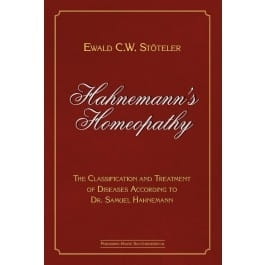The Classification and Treatment of Diseases according to Dr Samuel Hahnemann
Ever since his first day as a homeopath, nearly four decades ago, Ewald Stöteler (1957) has worked in exactly the same way as Samuel Hahnemann (doctor and pharmacist) has developed and recorded his philosophy.
He studied Hahnemann’s publications thoroughly and translated different editions of the Organon and The Chronic Diseases in Dutch. It became clear that Hahnemann worked from brilliant ideas, experiences, potencies and accurate experiments and reported these processes thoroughly in the subsequent editions of the Organon and The Chronic Diseases.
As precisely as Hahnemann, Ewald Stöteler is able to discover the valuable and specific timeline in the development that Hahnemann went through, during the development of his classic homeopathy, finalized in the 6th edition of the Organon. Hahnemann referred to this last edition as ‘which has now, if possible, become perfect’.
Homeopathy worldwide, is based on the 4th edition of the Organon, introduced by Kent and also because of that, alienated from its roots. The 5th and especially the 6th edition have been completely ignored by the rest of the world.
Ewald Stöteler fills the gap between the two extremes: the 4th and the 6th edition of Hahnemann’s Organon and his book The Chronic Diseases. That’s when it becomes clear that the principle of similarity is so much more than just choosing the right remedy.
A unique book is born. Hahnemann’s Homeopathy: a true gift, written by a man who places his love for homeopathy, his practice and his patients above everything else, and who knows that this is his purpose in life. A gift, because the synthesis of Hahnemann’s thoughts, developments and experiences become clear in Hahnemann’s Homeopathy.
This book, fills a huge gap between the unique knowledge of Samuel Hahnemann and the understanding of it, in order to be able to implement homeopathy successfully in daily practice.
- Author: Ewald Stoteler
- ISBN: 9789492665317
- 576 pages
- Hardback
- Published in 2019
- Printed in Netherlands
Reprinted with the permission of The Society of Homeopaths from 'The New Homeopath' Journal, Winter Edition, 2020. Reviewed by Francis Treuherz.
This is a revolutionary and exciting book. The author’s thesis is simple, but the details are very complex: namely that Hahnemann was right in the 6th edition of his Organon and in his Chronic Diseases. We may all ‘know’ that this is true but in fact we are following the ideas of the 4th edition of the Organon and the interpretations of Kent and those who followed him. Stöteler strongly holds that we need to use the LM or Q potencies and the miasmatic remedies of the last edition. The 4th edition of the Organon (1829) was translated in Dublin in 1833 and was republished in Pennsylvania in 1836. The influence of the 4th edition remains more powerful than the 5th and 6th to this day.
The main body of the book takes us in great detail through these ideas and how to put them into practice. The book is full of direct quotations from Hahnemann, signified by icons depicting the old books, and a change of font. Then the author interprets and explains these quotations in modern terminology. He cites his own experiences and at the end describes some patient case histories. There is great detail about the miasms. He divides up remedies by plant, mineral, anti-miasmatic and nosode and describes how to use more than one remedy in alternation. His only other real hero was James Compton Burnett.
He maintains that our idea of helping people is a mistake, Hahnemann concentrated on diseases as in the title of his masterwork Chronic Disease. When I was editor of The Homeopath I commissioned pharmacist John Morgan to write about the LM potencies, which have hardly been mentioned since then*. Helios had 8% of remedy sales as LM in 2019: (personal communication).
There are few flaws. The book is beautifully designed and bound, the contents and index are very detailed so it is easy to navigate. There are excellent illustrations, mainly portraits of Hahnemann. But there is no bibliography, just a vague list of sources. There is no indication of which translations of Hahnemann Stöteler used – although I compared his quotations and it appears to be the classics: Dudgeon’s Organon and the Tafel’s Chronic Diseases.
To sum up, the author makes an elegant and positive case for the LM potencies and Hahnemann’s approach to miasms.
*John Morgan: Dose, Dilution and the LM Potencies The Homeopath, Autumn 2006, p50.

